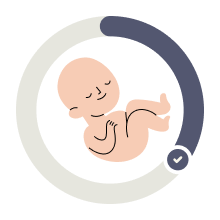Well done, on entering the second trimester of your pregnancy!!!!
As you enter week 13, you may feel a sense of relief as the risk of miscarriage decreases for many pregnant individuals. The exhaustion and fatigue that often accompany the first trimester may start to subside, and you might begin to feel more like your pre-pregnancy self. This can be an enjoyable time for many expectant parents, although experiences can vary. Let’s take a closer look at what you can expect during week 13 of your pregnancy.
Pregnancy Week 13 Quick Facts
- At 13th weeks, you’ve entered your fourth month of pregnancy (you’re 3month pregnant)
- You have 27 weeks until your due time “Calculate your due date”
- You’re entering your second trimester
Your Unborn Baby’s Size at 13 Weeks
The fetus weighs approximately 23 grams and measures around 7.4 centimeters in length, which is equivalent to about 0.81 ounces. It is comparable in size to a small peach or plum.
Pregnancy Symptoms Week 13
At 13 weeks pregnant, both single and twin pregnancies may share some similar symptoms, such as:
Breast pain: To monitor persistent breast pain, it’s advisable to limit caffeine intake to a maximum of one cup of coffee per day.
Fatigue: You may still feel tired, especially if you’re not getting enough sleep or rest.
Morning sickness: Nausea and vomiting may continue or even get worse for some women.
Frequent urination: As your uterus grows, it puts pressure on your bladder, causing you to need to pee more often.
Constipation: Hormonal shifts during pregnancy can result in slowed digestion, potentially causing constipation.
Heartburn: Your growing uterus can also push your stomach upward, causing acid reflux.
Swollen or bleeding gums: Swollen or bleeding gums can occur during pregnancy due to hormonal changes It’s important to maintain good oral hygiene habits.
In addition to these symptoms, twin pregnancies may have some unique symptoms:
Increased weight gain: You may gain weight more quickly than in a single pregnancy, as your body is supporting two babies.
Larger uterus: Your uterus will be bigger than in a single pregnancy, as it needs to accommodate two babies.
Stronger fetal movements: You may feel more fetal movements earlier than in a single pregnancy, as you have two babies moving around.
Higher levels of pregnancy hormones: You may have higher levels of hormones like estrogen and progesterone, which can cause stronger pregnancy symptoms.
Prenatal Tests and Doctor’s Appointments
Prenatal tests and doctor’s appointments during pregnancy are important to monitor the health and development of both the mother and the growing fetus(es).
Here are some common tests and appointments that may be recommended at 13 weeks of pregnancy:
Blood tests: Blood tests may be done to check for various markers, such as iron levels, blood type, and infections.
Ultrasound: An ultrasound may be performed to assess the growth and development of the fetus(es) and to check for any abnormalities.
Nuchal translucency screening: The nuchal translucency screening is a test usually conducted during the 11-13 week of pregnancy, aiming to measure the thickness of fluid at the back of the fetus’s neck. It helps evaluate the risk of Down syndrome and other chromosomal abnormalities.
Doctor’s appointment: At 13 weeks of pregnancy, you may have a routine check-up with your healthcare provider to monitor your overall health and the health of the fetus(es).
Multiple marker screening: This test measures various hormones and proteins in the mother’s blood to assess the risk of certain genetic disorders.
– Risk in the 13th week of pregnancy
The potential risks during the 13th week of pregnancy can vary depending on whether a woman is carrying a single fetus or multiple fetuses (twins or more).
For a woman carrying a single fetus, the risks may include:
Miscarriage: As mentioned earlier, the risk of miscarriage decreases significantly after the first trimester, but there is still a small risk of miscarriage during the 13th week of pregnancy.
Birth defects: The risk of birth defects is highest during the first trimester, but some birth defects may still develop during the 13th week of pregnancy.
Preeclampsia: During the 13th week of pregnancy, a serious condition known as preeclampsia can arise, which is characterized by high blood pressure and the presence of protein in the urine.
Infections: Pregnant women are more susceptible to infections, which can pose a risk to both the mother and the developing fetus.
For a woman carrying multiple fetuses, the risks may include:
Premature labor: Women carrying twins or more are at higher risk for premature labor, which can lead to complications for the infants.
Growth restriction: Multiple fetuses may compete for nutrients and space in the uterus, which can lead to growth restriction for one or more fetuses.
Preeclampsia: Women carrying multiples may be at increased risk for preeclampsia.
Cesarean delivery: Women carrying multiples are more likely to require a cesarean delivery due to the increased risk of complications during delivery.
It is important for women carrying multiples to receive specialized care from a healthcare provider who is experienced in managing multiple pregnancies. Additionally, women should attend regular prenatal check-ups to monitor the health of both the mother and the developing fetuses and to identify any potential risks early on.
Developmental Milestones
In terms of baby development, here are some common milestones that may occur at 13 weeks of pregnancy:
Single fetus: At 13 weeks, a single fetus is approximately the size of a lemon and may be around 3 inches long. The baby’s bones are beginning to harden, and he/she may be able to move his/her limbs and make facial expressions.
Twin fetuses: At 13 weeks, twin fetuses are also approximately the size of a lemon, but each baby may be slightly smaller than a single fetus at this stage. Both babies will be developing at a similar rate, and their organs and limbs are beginning to form.



